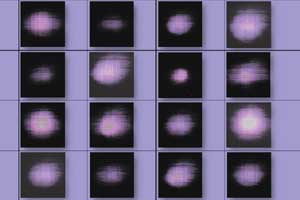Argonne Laboratory free-electron laser achieves saturation
 Scientists and engineers at Argonne National Laboratory’s Advanced Photon Source achieved “saturation” of self-amplified spontaneous emission in a mirrorless free-electron laser at a wavelength more than 1,000 times shorter than the previous record. The images show snapshots of the optical signal when the free-electron laser was tuned to a wavelength of 385 nm, which lies in the ultraviolet portion of the spectrum. |
This experiment is important because it demonstrates that free-electron lasers based on this process might one day provide laser-quality X-ray beams, opening new horizons for research in dozens of scientific fields.
The beam of light produced in the experiment had a wavelength of 385 nanometers, placing it in the ultraviolet region of the spectrum. The success of the particular process employed at Argonne is gauged by whether the free-electron laser effect has saturated. Saturation occurs at the point the electron beam yields the maximum power and converts it to coherent synchrotron radiation––the light emitted by high-energy electrons when magnets bend their flight paths. The Argonne device clearly exhibited saturation of the process.
“In the history of synchrotron radiation research, which is only about 45 years old, you can count the true breakthroughs on the fingers of one hand,” said David Moncton, Argonne’s Associate Laboratory Director for the Advanced Photon Source. “This is one of them.”
Scientists at laboratories around the world have been trying to develop a new version of the free-electron laser that can operate at X-ray wavelengths. This principle relies on a process called self-amplified spontaneous emission, which does not require mirrors, as do more conventional lasers. Instead, a self-amplified spontaneous emission free-electron laser requires a high-quality electron beam and a long array of high-quality magnets called an undulator.
When the electron beam passes through the undulator, the magnets vibrate the electrons from side to side, causing them to emit light as synchrotron radiation. The higher the electron energy becomes, the higher the resulting light energy will be.
As electron bunches propagate down the undulator, they are bathed in the same light they generate. As they wiggle back and forth through the magnets and interact with the electric field of this light, some gain energy and some lose energy, depending upon their phase relationship with the light and the magnetic fields.
As a result, the electrons begin to form microbunches separated by a distance equal to the wavelength of the light they generate. The light waves emitted by the electron bunches will line up in phase––meaning that the waves’ peaks and valleys overlay each other––to reinforce and amplify the light’s brilliance and intensity.
Eventually, a favorable runaway instability develops, which is similar to feedback heard from a public address system with its volume turned up too high. The light intensity grows exponentially along the undulator until the process saturates and the generated light is at its highest intensity. By the time the light beam emerges, its initial intensity has been amplified more than 1 billion times.
At high enough energy levels and with an adequately long undulator system, a free-electron laser could theoretically produce an X-ray beam with peak brightness more than 1 billion times greater than the brightest X-ray beams available today.
The next generation of X-ray sources for scientific research will be based on the free-electron laser concept. With further development, they promise to provide extremely bright, laser-like X-ray beams with ultra-short pulse durations, which will enable scientists to study the properties and structures of materials in far greater detail and in far less time than is currently possible.
Such research might include creating “snapshots” or “movies” of chemical and biological reactions that are too fast to be observed with existing sources, creating holographic images of proteins and other molecules and making an image of a single protein molecule with a single X-ray pulse.
Argonne is one of six U.S. research organizations collaborating on developing the technology needed to develop an X-ray free-electron laser. Others participating in the collaborations include the Stanford Linear Accelerator Center, the University of California at Los Angeles, and Brookhaven, Los Alamos and Lawrence Livermore national laboratories. Their collaboration is aimed at demonstrating the feasibility of the proposed Linac Coherent Light Source to be built at the Stanford Linear Accelerator Center.
![[Chronicle]](/images/small-header.gif)